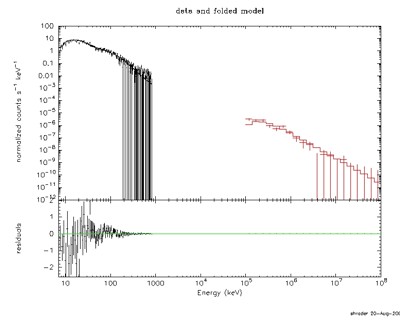Combined LAT and GBM analysis
Once you have completed this procedure for GBM burst analysis you may wish to perform a combined GBM and LAT analysis (be aware that only a small fraction of GBM burst have associated LAT detections- refer to the LAT burst summary table available through the FSSC website.
Assuming the GBM burst you have analyzed to this step is also detected with the LAT, you can follow the LAT Gamma-Ray Burst Analysis thread through each of the 4 steps. You can then for example use the XSPEC data grouping functionality to simultaneous apply a common spectral model to the appropriate LAT and GBM responses to fit the data, e.g.
XSPEC > data 1:1 yourGBMspectrum.pha
XSPEC > data 1:2 yourLATspectrum.pha
XSPEC > back 1:1 yourGBMback.pha
XSPEC > resp 1:1 GBM.rsp
XSPEC > resp 2:1 LAT.rsp
In this case we have assigned the GBM data (for a single detector) and the LAT data to a common data group (group 1) and to separate plot groups (1 for the GBM and 2 for the LAT). This can be easily generalized to incorporate multiple GBM detectors with the LAT. You can then fit models, such as the Band Function (known as the GRB function in XSPEC) to the combined GBM-LAT data. Refer to the XSPEC documentation for details, as a discussion of its use is beyond the scope of this document.
Note that data grouping capability also facilitates multiple GBM detector analyses or combinations of multiple GBM plus LAT analyses.
To illustrate an actual example, a screen shot (with some output suppressed) is shown below, and the resulting fit to a single GBM NaI detector and the LAT is plotted below.
The resulting fit to a single model is depicted here in detector count space. In this case the GRB spectrum is modeled up to ~3 GeV. The statistics on the GBM (10- 200-keV) band could be improved by including any other illuminated NaI detectors. Also note that, for a bright GRB such as this, the coverage gap between the NaI and LAT spectra could be bridged in part by the including the appropriate GBM BGO detector.
Last updated by: Analia Cillis 08/24/2009



